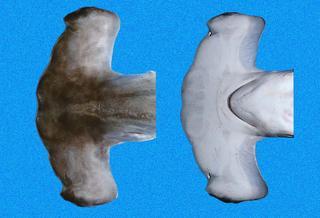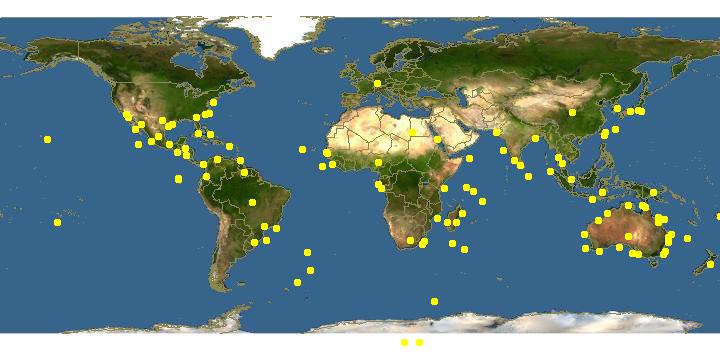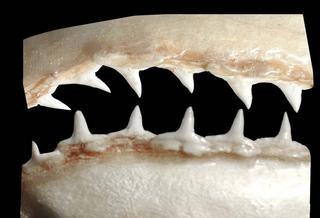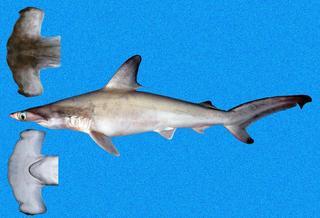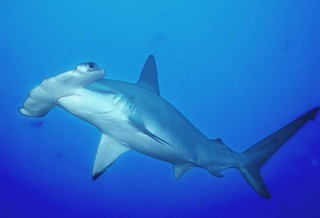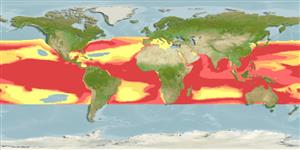|
| Links |
We parsed the following live from the Web into this page. Such content is managed by its original site and not cached on Discover Life. Please send feedback and corrections directly to the source. See original regarding copyrights and terms of use.
- Australian Faunal Directory
- FishBase
|
|
español |
|
|
Overview |
Main identification features
- hammer: wide, front convex + central notch
- 1st dorsal fin : rounded tip
- 2nd dorsal fin less than 3rd gill slit
A large hammerhead shark with broad (width of hammer 24-30% of total length) narrow-bladed side extensions on the head; front margin of head broadly convex, and scalloped due to a prominent middle indentation, a more conspicuous notch near the end of each side of the hammer (which sets off the end lobe bearing the eye), and a slight indentation in front margin between the central and side notches on each side; first dorsal fin moderately large and erect, rear margin concave, first dorsal fin with rounded tip; height of second dorsal fin < length of 3rd gill slit; free rear tip of second dorsal fin nearly reaching caudal fin; base of anal fin noticeably larger than that of second dorsal fin.
Brownish grey, shading to white ventrally; undersides of pectoral fins tipped with black.
Size: attains 430 cm; size at birth 42-55 cm.
Habitat: coastal and oceanic, young in shallow muddy areas.
Depth: 0-275 m.
Worldwide in tropical and warm temperate seas, California to northern Peru, plus all the oceanic islands.
Attributes
Abundance: Common.
Cites: Not listed.
Climate Zone: North Temperate (Californian Province &/or Northern Gulf of California); Northern Subtropical (Cortez Province + Sinaloan Gap); Northern Tropical (Mexican Province to Nicaragua + Revillagigedos); Equatorial (Costa Rica to Ecuador + Galapagos, Clipperton, Cocos, Malpelo).
Depth Range Max: 275 m.
Depth Range Min: 0 m.
Diet: octopus/squid/cuttlefish; bony fishes; mobile benthic gastropods/bivalves; sharks/rays; mobile benthic crustacea (shrimps/crabs).
Eastern Pacific Range: Northern limit=33; Southern limit=-4; Western limit=-118; Eastern limit=-78; Latitudinal range=37; Longitudinal range=40.
Egg Type: Live birth; No pelagic larva.
Feeding Group: Carnivore.
FishBase Habitat: Pelagic.
Global Endemism: Circumtropical ( Indian + Pacific + Atlantic Oceans); East Pacific + Atlantic (East +/or West); Transisthmian (East Pacific + Atlantic of Central America); East Pacific + all Atlantic (East+West); All Pacific (West + Central + East); TEP non-endemic; "Transpacific" (East + Central &/or West Pacific); All species.
Habitat: Reef associated (reef + edges-water column & soft bottom); Water column; Estuary.
Inshore Offshore: Inshore; Offshore; In & Offshore.
IUCN Red List: Near threatened; Listed.
Length Max: 430 cm.
Regional Endemism: Island (s); Continent; Continent + Island (s); Eastern Pacific non-endemic; Tropical Eastern Pacific (TEP) non-endemic; All species.
Residency: Resident.
Salinity: Brackish; Marine.
Water Column Position: Mid Water; Near Bottom; Water column only;
|
|
|
Names | |
|
|
|
Links to other sites | |
|
|
|
References |
- Acero, A. and Franke, R., 2001., Peces del parque nacional natural Gorgona. En: Barrios, L. M. y M. Lopéz-Victoria (Eds.). Gorgona marina: Contribución al conocimiento de una isla única., INVEMAR, Serie Publicaciones Especiales No. 7:123-131.
- Allen , G.R. and Robertson, D.R., 1997., An Annotated Checklist of the fishes of Clipperton Atoll, Tropical Eastern Pacific., Revista de Biologia Tropical, 45:813-843.
- Bellido-Millán, J.M. and Villavicencio-Garayzar, C.J., 2002., Pesqueria artesanal de tiburon en la region central del Golfo de California. En: Lozano-Vilano, M. L. (Ed.). Libro Jubilar en Honor al Dr. Salvador Contreras Balderas., Universidad Autonoma de Nuevo León:143-152.
- Béarez, P., 1996., Lista de los Peces Marinos del Ecuador Continental., Revista de Biologia Tropical, 44:731-741.
- Castri-Aguirre, J.L., Espinoza-Pérez, H. and Schmitter-Soto, J.J., 2002., Lista sitemática, biogeográfica y ecológica de la ictiofauna estuarino lagunar y vicaria de México. En: Lozano-Vilano, M. L. (Ed.). Libro Jubilar en Honor al Dr. Salvador Contreras Balderas., Universidad Autonoma de Nuevo León:117-142.
- Castro-Aguirre, J.L. and Balart, E.F., 2002., La ictiofauna de las islas Revillagigedos y sus relaciones zoogeograficas, con comentarios acerca de su origen y evolucion. En: Lozano-Vilano, M. L. (Ed.). Libro Jubilar en Honor al Dr. Salvador Contreras Balderas., Universidad Autonoma de Nuevo León:153-170.
- Castro-Aguirre, J.L., 1999., Ictiofauna estuarino-lagunar y vicaria de México., Editorial Limusa S.A. de C.V.: 1-629pp.
- Compagno, L.J.V., 1999., Checklist of living elasmobranchs. In Hamlett W.C. (ed.) Sharks, skates, and rays: the biology of elasmobranch fishes., The John Hopkins University Press:471-498.
- Compagno, L.J.V., 1984., Sharks of the World. An annotated and illustrated catalogue of shark species known to date. Part 2. Carcharhiniformes. FAO Species Catalogue., FAO Fish. Synop. No 125, 4(2):251-655.
- Cuesta, T.C., 1932., Lista de los peces de las costas de la Baja California., Inst. Biol. Mexico, Anal, 3(1):75-80.
- Edgar, G.J. Banks, S., Fariña, J.M., Calvopiña, M. and Martínez, C., 2004., Regional biogeography of shallow reef fish and macro-invertebrate communities in the Galapagos archipelago., Journal of Biogeography, 31:1107-1124.
- Findley, L.T., Hendrickx, M.E., Brusca, R.C., van der Heiden, A.M., Hastings, P.A., Torre, J., 2003., Diversidad de la Macrofauna Marina del Golfo de California, Mexico., CD-ROM versión 1.0. Projecto de la Macrofauna del Golfo . Derechos reservados de los autores y Conservación Internacional.
- Fischer , W. , Krup , F. , Schneider , W. , Sommer , C. , Carpenter , K. E. and Niem, V. H., 1995., Guia FAO para la Identificacion de Especies de para los fines de la Pesca. Pacifico Centro-Oriental. Volumen II. Vertebrados - Parte 1., FAO2:647-1200.
- Galván-Magaña, F., Abitia-Cárdenas, L.A., Rodríguez-Romero, J., Pérez-España, H., Chávez-Ramos, H., 1996., Systematics list of the fishes from Cerralvo island, Baja California Sur, Mexico., Ciencias Marinas, 22:295-311.
- Galván-Magaña, F., Gutiérrez-Sánchez, F., Abitia-Cárdenas, L.A., Rodríguez-Romero, J., 2000., The distribution and affinities of the shore fishes of the Baja California Sur lagoons. In Aquatic Ecosystems of Mexico: Status and Scope. Eds. M. Manuwar, S.G. Lawrence, I.F. Manuwar & D.F. Malley. Ecovision World Monograph Series., Backhuys Publishers:383-398.
- Griffith, E., Smith, C. H., 1834., The class Pisces, arranged by the Baron Cuvier, with supplementary additions, by Edward Griffith, F.R.S., &c. and Lieut.-Col. Charles Hamilton Smith, F.R., L.S.S., Cuvier:1-680, Pls. 1-62 + 3.
- Humann, P., 1993., Reef Fish Identification: Galapagos., New World Publishing:192pp.
- Jimenez-Prado, P., Béarez, P., 2004., Peces marinos del Ecuador continental / Marine fishes of continental Ecuador., SIMBIOE/NAZCA/IFEA tomo 1 y 2.
- Lea, R.N. and Rosenblatt, R.H., 2000., Observations on fishes associated with the 1997-1998 El Niño off California., CalCOFL Rep., 41:117-129.
- Lopez , M. I. and Bussing, W. A., 1982., Lista provisional de los peces marinos de la Costa Rica., Revista de Biologia Tropical, 30(1):5-26.
- Love, M.S., Mecklenburg, C.W., Mecklenburg, T.A., Thorsteinson, L.K., 2005., es of the West Coast and Alaska: a checklist of North Pacific and Artic Ocena species from Baja California to the Alaska-Yukon border., U.S. Department of the Interior, U.S. Geological Survey, Biological Resources Division, 288pp.
- Madrid Vera , J. , Ruíz Luna , A. and Rosado Bravo, I., 1998., Peces de la plataforma continental de Michoacán y sus relaciones regionales en el Pacífico mexicano., Revista de Biologia Tropical, 42(2):267-276.
- Minckley, W.L., 2002., Fishes of the lowermost colorado river, its delta, and estuary: a commentary on biotic change. En: Lozano-Vilano, M. L. (Ed.). Libro Jubilar en Honor al Dr. Salvador Contreras Balderas., Universidad Autonoma de Nuevo León:63-78.
- Orellana, J.J., 1985., Marine Fishes of Los Cóbanos: Fishes of El Salvador., Sigma Found:126pp.
- Phillips, P. C., 1981., Annotated Checklist of Fishes at Jiquilisco Bay, El Salvador., Revista de Biologia Tropical, 29:45-58.
- Pérez-Mellado, J., Findley, LL. F., 1985., Evaluación de la ictiofauna acompañante del camarón capturado en las costas de Sonora y norte de Sinaloa, México. In Yáñez-Arancibia, A. (Ed.) Recursos pesqueros potenciales de México: La pesca acompañante del camarón., Universidad Nacional Autónoma de México: Cap. 5:201-254.
- Ramírez Rodríguez, M., 1997., Producción pesquera en la Bahía de La Paz, B.C.S.. En Urbán Ramírez, J. y M. Ramírez Rodríguez (Eds.). La Bahía de La Paz investigación y conservación., Universidad Autónoma de Baja California Sur:273-282.
- Robertson , D.R. and Allen, G.A., 1996., Zoogeography of the shorefish fauna of Clipperton Atoll., Coral Reefs, 15:121-131.
- Rubio , R. E. A. and Estupiñan, F., 1990., Ictiofauna del Parque Nacional Natural Sanquianga, un Analisis de su Estructura y Perspectivas para su Manejo., Memorias del VII Seminario Nacional de las Ciencias y Tecnologías del Mar. Comisión Colombiana de Oceanografía. Bogota, Colombia., :660-670.
- Rubio, E.A., 1986., Notas sobre la ictiofauna de la Isla de Gorgona, Colombia., Boletin Ecotropica. Univ. Bog. Jorge Tadeo Lozano, 13:86-112.
- Rubio, E.A., 1988., Estudio taxonomico de la ictiofauna acompañante del camaron en areas costeras del Pacifico de Colombia., Memorias del VI Seminario Nacional de las Ciencias del Mar. Comisión Colombiana de Oceanografía. Bogota, Colombia., :169-183.
- Sánchez Ortíz , C. , Arreola Robles , J. L. , Aburto Oropeza , O. and Cortés Hernández, M., 1997., Peces de arrecife en la región de La Paz, B.C.S.. En Urbán Ramírez, J. y M. Ramírez Rodríguez (Eds.). La Bahía de La Paz investigación y conservación., Universidad Autónoma de Baja California Sur:189-200.
- Van der Heiden , A. M. and Findley, L. T., 1988., Lista de los peces marinos del sur de Sinaloa, México., Anales del Centro de Ciencias del Mar y Limnologia de la Universidad Autonoma Nacional de Mexico, 15:209-224.
- Villavicencio Garayzar , C. J. , Mariano Meléndez , E. and Downton Hoffmann, C., 1997., Tiburones capturados comercialmente en la Bahía de La Paz, B.C.S.. En Urbán Ramírez, J. y M. Ramírez Rodríguez (Eds.). La Bahía de La Paz investigación y conservación., Universidad Autónoma de Baja California Sur:201-236.
- Walker, B. W. and Baldwin, W. J., 1964., Provisional check list of fishes of the Revillagigedo islands., 18 pp.
|
|
|
Acknowledgements | |
I thank Ashley MacDonald and John Pickering, University of Georgia, for technical support in building this page.
|
|
| Supported by | |
|
Following modified from Australian Faunal Directory
|
Top | See original
| &pull 20q v5.145 20180528: Error 301 Moved Permanently http://biodiversity.org.au/afd/taxa/80490086-0684-48f4-92ce-e8f9bd6c4242 |
|
Following modified from FishBase
|
Top | See original
http://www.fishbase.org/Summary/speciesSummary.php?genusname=Sphyrna&speciesname=lewini ---> http://52.67.158.155/Summary/speciesSummary.php?genusname=Sphyrna&speciesname=lewini
http://52.67.158.155/Summary/speciesSummary.php?genusname=Sphyrna&speciesname=lewini ---> https://fishbase.net.br/Summary/speciesSummary.php?genusname=Sphyrna&speciesname=lewini
https://fishbase.net.br/Summary/speciesSummary.php?genusname=Sphyrna&speciesname=lewini ---> https://fishbase.net.br/summary/Sphyrna-lewini.html
Sphyrna lewini, Scalloped hammerhead : fisheries, gamefish

You can
sponsor
this page
Common name (e.g. trout)
Genus + Species (e.g. Gadus morhua)
-

-
About this page
-
Languages
-
User feedbacks
-
Citation
-
Uploads
-
Related species
-


 Scalloped hammerhead
Add your observation in
Fish Watcher
Upload your
photos
and
videos
Scalloped hammerhead
Add your observation in
Fish Watcher
Upload your
photos
and
videos
Pictures
|
Videos |
Stamps, Coins Misc.
|
Google image
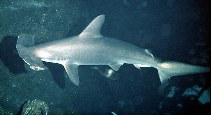 Sphyrna lewini
Sphyrna lewini
Picture by
Randall, J.E.
Elasmobranchii (sharks and rays) >
Carcharhiniformes
(Ground sharks) >
Sphyrnidae
(Hammerhead, bonnethead, or scoophead sharks)
Etymology:
Sphyrna:
Probable misspelling of
sphyra
(Gr.), hammer, referring to their hammer-shaped heads. (
See ETYFish
)
;
lewini:
Patronym not identified, perhaps in honor of John Lewin (1770-1819), who illustrated early volumes of Australian natural history (this shark was described from Australia) and may be the âMr. Lewinâ who illustrated the plates in Griffith and Smithâs book. (
See ETYFish
)
.
Environment: milieu / climate zone / depth range / distribution range
Ecology
Marine; brackish; pelagic-oceanic; oceanodromous (Ref.
51243
); depth range 0 - 1043 m (Ref.
89972
), usually 0 - 25 m (Ref.
26999
). Tropical; 46°N - 39°S, 180°W - 180°E
Circumglobal in coastal warm temperate and tropical seas (Ref.
13562
). Western Atlantic: New Jersey, USA to Uruguay (Ref.
58839
), including the Gulf of Mexico and Caribbean. Eastern Atlantic: western Mediterranean (Ref.
6678
) to Namibia (Ref.
6812
). Indo-Pacific: Persian Gulf (Ref.
68964
), Red Sea, East Africa and throughout the Indian Ocean; Japan to New Caledonia, Hawaii and Tahiti. Eastern Pacific: southern California, USA to Ecuador, probably Peru.
Length at first maturity / Size / Weight / Age
Maturity: L
m
210.5
, range 140 - 273 cm
Max length : 430 cm TL male/unsexed; (Ref.
26938
); common length : 360 cm TL male/unsexed; (Ref.
13562
); max. published weight: 152.4 kg (Ref.
40637
); max. reported age: 35 years (Ref.
31395
)
Dorsal
spines
(total): 0;
Dorsal
soft rays
(total): 0;
Anal
spines
: 0;
Anal
soft rays
: 0. This hammerhead shark is distinguished by having the following characters: large, moderately slender body; broad, narrow bladed head, arched anterior margin with prominent median indentation and lateral indentation; nostrils with strong prenarial grooves; hind margins of eyes slightly posterior to or nearly opposite front of mouth; teeth triangular, deeply notched posteriorly, with smooth or finely serrated edges; first dorsal fin moderately high, second dorsal and pectoral fins low; upper precaudal pit transverse crescentric. Colour of body light grey or greyish brown above, shading to white below, pectoral fin tips dusky and a dark blotch on lower caudal fin lobe (Ref.
13562
,
114967
).
A coastal-pelagic, semi-oceanic shark occurring over continental and insular shelves and adjacent deep water, often approaching close inshore and entering enclosed bays and estuaries (Ref.
244
,
11230
,
58302
). Found in inshore and offshore waters to about 275 m depth (Ref.
26938
,
11230
,
58302
); has been filmed at a baited camera in 512 m depth (Lis Maclaren, pers. comm. 2005). Huge schools of small migrating individuals move pole ward in the summer in certain areas (Ref.
244
). Permanent resident populations also exist (Ref.
244
). Juveniles occur in coastal areas (Ref.
58784
). Adults solitary, in pairs, or schools; young in large schools (Ref.
13562
). Feed mainly on teleost fishes and cephalopods (Ref.
6871
), also lobsters, shrimps, crabs (Ref.
30573
), including other sharks and rays (Ref.
37816
). Viviparous (Ref.
50449
). Mature females produce 15-31, of 43-55 cm young in a litter (Ref.
26938
,
1602
). Considered potentially dangerous to people but often not aggressive when approached by divers (Ref.
13562
). Readily available to inshore artisanal and small commercial fisheries as well as to offshore operations (Ref.
13562
). Sold fresh, dried-salted, smoked and frozen; also sought for its fins and hides (Ref.
9987
). Oil used for vitamins and carcasses for fishmeal (Ref.
13562
). Maximum depth from Ref. 125614.
Viviparous, placental (Ref.
50449
), with 13-23 in a litter (Ref.
6871
); 12-41 pups after a gestation period of 9-10 months (Ref.58048). Size at birth 45-50 cm TL (Ref.
13562
); 39-57 cm TL (Ref.58048).
Compagno, L.J.V.
, 1984. FAO Species Catalogue. Vol. 4. Sharks of the world. An annotated and illustrated catalogue of shark species known to date. Part 2 - Carcharhiniformes. FAO Fish. Synop. 125(4/2):251-655. Rome: FAO. (Ref.
244
)
IUCN Red List Status (Ref.
130435
)
Critically Endangered (CR)
(A2bd); Date assessed:
08 November 2018
CITES
Appendix II:
International trade monitored
Appendix II:
Migratory species conserved through agreements
Threat to humans
Other (Ref.
13562
)
Human uses
Fisheries: commercial; gamefish: yes
FAO - Fisheries:
landings
,
species profile
; Publication:
search
| FIRMS -
Stock assessments
|
FishSource
|
Sea Around Us
More information
Countries
FAO areas
Ecosystems
Occurrences
Introductions
Stocks
Ecology
Diet
Food items
Food consumption
Ration
Common names
Synonyms
Metabolism
Predators
Ecotoxicology
Reproduction
Maturity
Spawning
Spawning aggregation
Fecundity
Eggs
Egg development
Age/Size
Growth
Length-weight
Length-length
Length-frequencies
Morphometrics
Morphology
Larvae
Larval dynamics
Recruitment
Abundance
BRUVS
References
Aquaculture
Aquaculture profile
Strains
Genetics
Electrophoreses
Heritability
Diseases
Processing
Nutrients
Mass conversion
Collaborators
Pictures
Stamps, Coins Misc.
Sounds
Ciguatera
Speed
Swim. type
Gill area
Otoliths
Brains
Vision
Tools
Bio-Quiz
|
E-book
|
Field guide
|
Identification keys
|
Length-frequency wizard
|
Life-history tool
|
Point map
|
Classification Tree
|
Catch-MSY
|
Special reports
Check for Aquarium maintenance
|
Check for Species Fact Sheets
|
Check for Aquaculture Fact Sheets
Download XML
Summary page
|
Point data
|
Common names
|
Photos
Internet sources
AFORO (otoliths) |
Aquatic Commons
|
BHL
|
Cloffa
|
BOLDSystems
|
Websites from users
|
Check FishWatcher
|
CISTI
|
Catalog of Fishes
:
genus
,
species
|
DiscoverLife
|
DORIS
|
ECOTOX
| FAO - Fisheries:
landings
,
species profile
; Publication:
search
|
Faunafri
|
Fishipedia
|
Fishtrace
| GenBank:
genome
,
nucleotide
|
GloBI
|
GoMexSI
(interaction data)
|
Google Books
|
Google Scholar
|
Google
|
IGFA World Record
|
MitoFish
|
National databases
|
OceanAdapt
|
Otolith Atlas of Taiwan Fishes
|
PubMed
| Reef Life Survey |
Socotra Atlas
|
Tree of Life
| Wikipedia:
Go
,
Search
| World Records Freshwater Fishing |
Zoological Record
Estimates based on models
Preferred temperature (Ref.
123201
): 18.7 - 29, mean 27.2 °C (based on 2890 cells).
Phylogenetic diversity index (Ref.
82804
): PD
50
= 0.5029 [Uniqueness, from 0.5 = low to 2.0 = high].
Bayesian length-weight: a=0.00355 (0.00281 - 0.00449), b=3.10 (3.03 - 3.17), in cm total length, based on LWR estimates for this species (Ref.
93245
).
Trophic level (Ref.
69278
): 4.1 ±0.5 se; based on diet studies.
Generation time: 13.7 (11.0 - 15.5) years. Estimated as median ln(3)/K based on 15
growth studies.
Resilience (Ref.
120179
): Low, minimum population doubling time 4.5 - 14 years (rm=0.028; K=0.05-0.24; tm=3-15; tmax=41.6; Fec=13-23).
Prior r = 0.06, 95% CL = 0.04 - 0.10, Based on 2 stock assessments.
Fishing Vulnerability (Ref.
59153
): Very high vulnerability (78 of 100).
Climate Vulnerability (Ref.
125649
): High vulnerability (62 of 100).
Price category (Ref.
80766
):
Medium
.
Nutrients (Ref.
124155
): Calcium = 11.1 [2.3, 63.0] mg/100g; Iron = 0.63 [0.15, 2.02] mg/100g; Protein = 19.7 [17.6, 22.0] %; Omega3 = 0.129 [0.051, 0.334] g/100g; Selenium = 84.6 [24.3, 265.5] μg/100g; VitaminA = 9.24 [3.00, 30.53] μg/100g; Zinc = 0.642 [0.304, 1.209] mg/100g (wet weight);
Back to Search
Random Species
Back to Top
Accessed through:
Not available
FishBase mirror site :
Laguna, Philippines
Page last modified by :
mrius-barile
|
Updated: 2024-04-25 07:37:42 gmt
|
